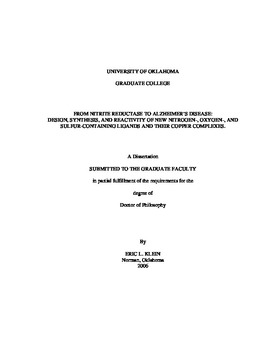| dc.contributor.advisor | Houser, Robert P., | en_US |
| dc.contributor.author | Klein, Eric L. | en_US |
| dc.date.accessioned | 2013-08-16T12:20:00Z | |
| dc.date.available | 2013-08-16T12:20:00Z | |
| dc.date.issued | 2006 | en_US |
| dc.identifier.uri | https://hdl.handle.net/11244/965 | |
| dc.description.abstract | Transition metal ions are essential for a wide range of biochemical transformations and are found in more than one half of all known enzymes. Our interest in the bioinorganic chemistry of copper prompted us to develop new model complexes that more accurately mimic structural aspects of the copper-containing nitrite reductase (CuNiR) active site, which contains a type 1 ("blue") electron transfer center that is coupled via a His-Cys bridge to a type 2 ("normal") catalytic center. Preliminary attempts to achieve this goal by covalently linking 1,4,7-triazacyclononane (TACN) and His were thwarted by synthetic challenges. Using less reactive amino acids, however, the first structurally characterized copper(II) complexes of TACN-Ala, -Gly, and -Phe were obtained and studied. These new complexes provide insight into the copper coordination chemistry of TACN, where one of its secondary amines has been converted to a tertiary amide. As an offshoot of this project, mononuclear copper(II) complexes of a new N2S(thioether) ligand were also obtained and fully characterized. The reactivity of these complexes with thiolates was investigated in an effort to produce new N2S(thioether)S(thiolate) type 1 copper center models. Although stable copper(II)-thiolate complexes could not be obtained, the redox decomposition of one of these proceeds by way of an unprecedented pathway that requires two equivalents of thiolate to fully reduce copper(II) to copper(I). Finally, a related ligand that contains two thioethers was also prepared. Attempts to produce copper(II) complexes of this ligand result in unanticipated redox decomposition that is dependent on the presence of both thioether sulfurs. This work has direct relevance to a recent proposal implicating Met sulfur in Alzheimer's Disease amyloid-beta neurotoxicity. | en_US |
| dc.format.extent | xix, 160 leaves : | en_US |
| dc.subject | Metalloenzymes. | en_US |
| dc.subject | Chemistry, Inorganic. | en_US |
| dc.subject | Ligands (Biochemistry) | en_US |
| dc.subject | Copper enzymes. | en_US |
| dc.title | From nitrite reductase to Alzheimer's disease: Design, synthesis, and reactivity of new nitrogen-, oxygen-, and sulfur-containing ligands and their copper complexes. | en_US |
| dc.type | Thesis | en_US |
| dc.thesis.degree | Ph.D. | en_US |
| dc.thesis.degreeDiscipline | Department of Chemistry and Biochemistry | en_US |
| dc.note | Adviser: Robert P. Houser. | en_US |
| dc.note | Source: Dissertation Abstracts International, Volume: 66-12, Section: B, page: 6612. | en_US |
| ou.identifier | (UMI)AAI3203325 | en_US |
| ou.group | College of Arts and Sciences::Department of Chemistry and Biochemistry | |
